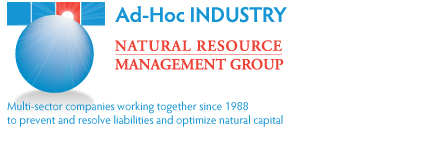|
Activities/ Resources
The following materials have been developed via cooperative activity among industry and government under the auspices of the Group's Industry/Trustee NRD Standing Committee. Among the resources that have been developed are those listed below -- all of which are aimed at helping multi-stakeholder practitioners in site-specific instances and encourage reasonable, balanced and predictable practices.
Resource #1: Natural Resource Damage Assessment (NRDA) and Restoration Best Practice Approach Principles and General Standards
This document contains a set of well-established principles reflecting the collective experience of seasoned private and public sector practitioners relative to natural resource damage assessment and restoration practices in the US. The principles are aimed at fostering the achievement of timely and cost-effective restoration of natural resources at federal and state sites nationwide. See Guiding Principles.
Resource #2: Cooperative NRDA Guiding Principles and Compendium of Sample Provisions
This document contains guiding principles and sample cooperative NRDA provisions collected from various trustee/industry Memoranda of Agreement or Understanding, intended to encourage a reasonable, strategic approach to the cooperative NRDA process and reflect common sense approaches developed by very seasoned trustees and industrial parties. It is intended to be used as a tool by parties at a particular site to initiate a cooperative/coordinated NRDA process between trustees and industrial parties, as well as help identify and address any issues that can bog down agreement on the terms of a cooperative NRDA, thus allowing stakeholders to save time and resources, as well as facilitate communication among the parties. See Cooperative NRDA Principles and Sample Provisions.
Resource #3: Searchable Restoration Project Catalog
This catalog providing comprehensive information on natural resource restoration projects selected and/or implemented at sites across the United States in the context of natural resource damage (NRD) cases and sites under CERCLA, OPA, the Clean Water Act and other federal statutes. The database, containing consolidated information on natural resource restoration projects at actual sites, searchable by over 12 parameters, can save time and resources when seeking to identify restoration projects with like parameters. See Catalog.
Resource #4: Third Party Neutral Approaches in the Context of NRDAs
This initiative encouraging consideration and use of third-party neutral approaches where this can be potentially useful in moving a case ahead and/or moving it to conclusion. This document was the result of a Continuing Legal Education (CLE) multi-stakeholder seminar convened by the Group in cooperation with the Federal Bar Association in 2019 to discuss ways to use third party neutral approaches in a variety of environmental contexts including natural resource damage cases under CERCLA, Clean Water Act, Oil Pollution Act and analogous laws in over 40 States. The materials are intended to facilitate the conduct of NRDAs, including settling contribution determinations, facilitating faster settlements, arriving at an agreed upon baseline for damage assessments, agreeing on cleanup/restoration coordination and various other aspects of the NRDA process. See CLE Program Agenda and Presentations and Summary Document.
Additional resources will be posted here as available.
|

